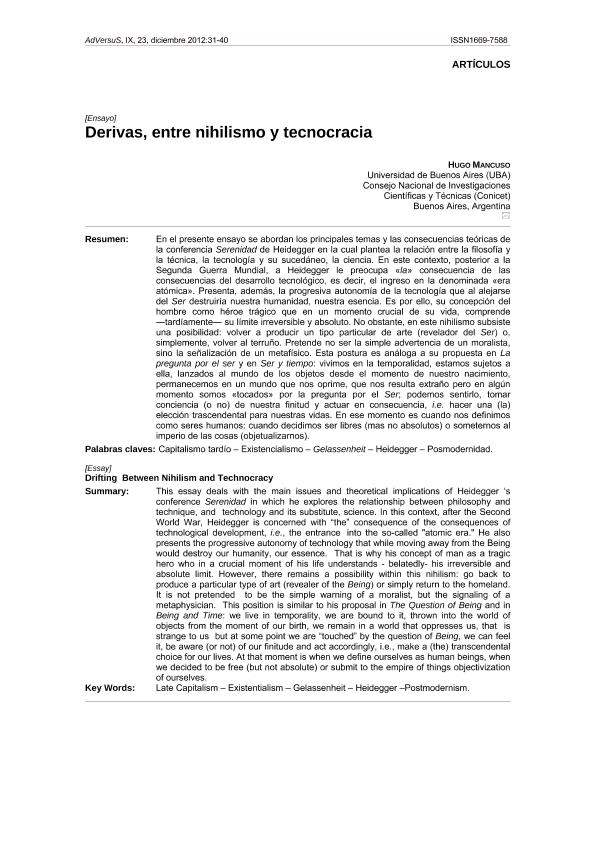Artículo
En el presente ensayo se abordan los principales temas y las consecuencias teóricas de la conferencia Serenidad de Heidegger en la cual plantea la relación entre la filosofía y la técnica, la tecnología y su sucedáneo, la ciencia. En este contexto, posterior a la Segunda Guerra Mundial, a Heidegger le preocupa «la» consecuencia de las consecuencias del desarrollo tecnológico, es decir, el ingreso en la denominada «era atómica». Presenta, además, la progresiva autonomía de la tecnología que al alejarse del Ser destruiría nuestra humanidad, nuestra esencia. Es por ello, su concepción del hombre como héroe trágico que en un momento crucial de su vida, comprende ―tardíamente― su límite irreversible y absoluto. No obstante, en este nihilismo subsiste una posibilidad: volver a producir un tipo particular de arte (revelador del Ser) o, simplemente, volver al terruño. Pretende no ser la simple advertencia de un moralista, sino la señalización de un metafísico. Esta postura es análoga a su propuesta en La pregunta por el ser y en Ser y tiempo: vivimos en la temporalidad, estamos sujetos a ella, lanzados al mundo de los objetos desde el momento de nuestro nacimiento, permanecemos en un mundo que nos oprime, que nos resulta extraño pero en algún momento somos «tocados» por la pregunta por el Ser; podemos sentirlo, tomar conciencia (o no) de nuestra finitud y actuar en consecuencia, i.e. hacer una (la) elección trascendental para nuestras vidas. En ese momento es cuando nos definimos como seres humanos: cuando decidimos ser libres (mas no absolutos) o someternos al imperio de las cosas (objetualizarnos). This essay deals with the main issues and theoretical implications of Heidegger ‘s conference Serenidad in which he explores the relationship between philosophy and technique, and technology and its substitute, science. In this context, after the Second World War, Heidegger is concerned with “the” consequence of the consequences of technological development, i.e., the entrance into the so-called "atomic era." He also presents the progressive autonomy of technology that while moving away from the Being would destroy our humanity, our essence. That is why his concept of man as a tragic hero who in a crucial moment of his life understands - belatedly- his irreversible and absolute limit. However, there remains a possibility within this nihilism: go back to produce a particular type of art (revealer of the Being) or simply return to the homeland. It is not pretended to be the simple warning of a moralist, but the signaling of a metaphysician. This position is similar to his proposal in The Question of Being and in Being and Time: we live in temporality, we are bound to it, thrown into the world of objects from the moment of our birth, we remain in a world that oppresses us, that is strange to us but at some point we are “touched” by the question of Being, we can feel it, be aware (or not) of our finitude and act accordingly, i.e., make a (the) transcendental choice for our lives. At that moment is when we define ourselves as human beings, when we decided to be free (but not absolute) or submit to the empire of things objectivization of ourselves.
Derivas, entre nihilismo y tecnocnocracia
Título:
Drifting Between Nihilism and Technocracy
Fecha de publicación:
12/2012
Editorial:
Istituto Italo-argentino di Ricerca Sociale
Revista:
Adversus
ISSN:
1669-7588
Idioma:
Español
Tipo de recurso:
Artículo publicado
Clasificación temática:
Resumen
Palabras clave:
CAPITALISMO TARDIO
,
EXISTENCIALISMO
,
POSMODERNIDAD
Archivos asociados
Licencia
Identificadores
Colecciones
Articulos(SEDE CENTRAL)
Articulos de SEDE CENTRAL
Articulos de SEDE CENTRAL
Citación
Mancuso, Hugo Rafael; Derivas, entre nihilismo y tecnocnocracia; Istituto Italo-argentino di Ricerca Sociale; Adversus; 9; 23; 12-2012; 31-40
Compartir




